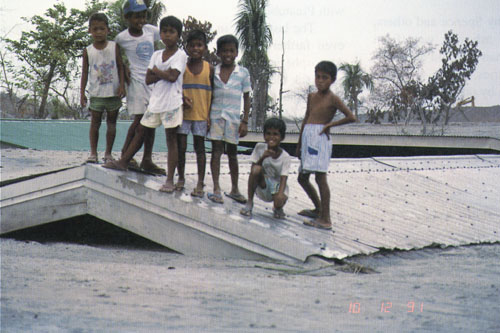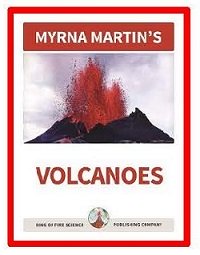What are Lahars?
Lahars are volcanic mudflows
Lahars look similar to flowing concrete
Lahars are mudflows that originate on the slopes of a volcano. The
mudflows contain so much rock debris they look and feel like flowing wet
concrete. They are triggered by a variety of events including
pyroclastic flows, rainstorms and the collapse of debris dams.

Philippine students standing on the roof of their school after a lahar destroyed it USGS
Damage caused by lahars
Debris mudflows
Pyroclastic flows contain superheated gases and rock debris that
explodes from a mountain during a volcanic eruption. Glaciers on
volcanoes melt as the pyroclastic flow roars down the mountain, creating
debris filled mudflows in their wake.
Debris dams
Debris clogging a river channel can create a dam. The water
backing up behind the dam forms a lake. Melting snow or rainfall can
cause the dam to collapse triggering a large lahar choked with debris
that had accumulated behind the dam.
Destructive lahars
Mudflows containing heavy loads of
ash and debris can carry boulders and logs down the mountain that act as
battering rams destroying everything in their path.


Click for More Information and to Order
1985 Armero, Columbia lahar
Armero, Columbia
The town of Armero in Columbia was struck by a mudflow in 1985. The
mudflow began when a small pyroclastic occurred on Nevado del Ruiz, a
volcano about 30 miles away. The mudflow was 9 to 15 feet high when it
struck the village late at night as the people in the village sleeping.
Twenty-two thousand people were killed by the lahar.
Multiple lahars daily on pinatubo
Pinatubo mudflows
Hundreds of volcanic mudflows swept down Mount Pinatubo following the
eruption of Mount Pinatubo in 1991. During the monsoon season that year
there were often two or three mudflows each day that carried mud and
rock debris from the upper slopes into the valleys below.
KIDS FUN Science Bookstore
Check out Myrna Martin's award winning textbooks, e-books, videos and rock sets. The Kids Fun Science Bookstore covers a wide range of earth science topics. Click here to browse.










